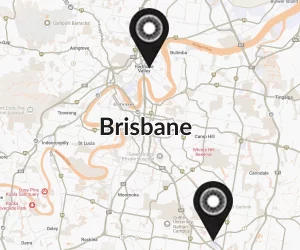
100 things you need to know about laser eye surgery (The complete list)
Are you considering laser eye surgery in Brisbane? It’s a big decision, and there’s a lot to know before you go through with it. Here is a complete list of everything you need to know about laser eye surgery. By the time you’re done reading this post, you’ll be an expert on the topic, and the laser surgery options available to you so you can decide if you are ready to experience freedom from glasses!
Prevalence & benefits
- Since 1990, over 30 million people have had laser eye surgery and achieved independence from glasses and contact lenses1Laser Eye Surgery Hub. 2020. Laser Eye Surgery Risks And Success Rates. UK. https://www.lasereyesurgeryhub.co.uk/laser-eye-surgery-risks-success-rates/.
- With 16.3 million procedures performed worldwide, and more than a decade of clinical studies and technological innovation, LASIK surgery should be considered among the most successful elective procedures2Solomon KD, Fernández de Castro LE, Sandoval HP, Biber JM, Groat B, Neff KD, Ying MS, French JW, Donnenfeld ED, Lindstrom RL; Joint LASIK Study Task Force. LASIK world literature review: quality of life and patient satisfaction. Ophthalmology. 2009 Apr;116(4):691-701. doi: 10.1016/j.ophtha.2008.12.037. Review. PubMed PMID: 19344821. https://www.ncbi.nlm.nih.gov/pubmed/19344821.
- Surgical vision correction options date as far back as the 19th century. In 1898, a method known as Radial Keratotomy (RK) was introduced to treat conditions such as nearsightedness.
- In total, most patients spend more than 365 full days of their life fiddling with glasses and/or contact lenses – imagine what fun things you could do with that time instead.
- After laser, you will have a whole new range of opportunities, both in terms of your lifestyle, social opportunities and opportunities in terms of how you see yourself. You will really feel different about life. You will feel energised by being free of your glasses and you can get on with the life that you really want.
Glasses & contact lenses
- Wearing contact lenses puts you at risk of several serious conditions and other long-term complications, including eye infections and corneal ulcers.3Center for Devices and Radiological Health (2018). Contact Lens Risks. [online] U.S. Food and Drug Administration.
- Contact lens wearers often complain of headaches. While many things can contribute to chronic headaches, contact lenses may be one.
- A poorly fitted contact lens could result in dry eyes. And when your eyes are dry, your contact lenses tend to tighten, resulting in headaches.
- The reason you need to wear glasses is that the focusing power of the eye hasn’t developed quite accurately. The eye is effectively like a camera that’s out of focus. When you wear contact lenses or glasses, you place a lens in front of the optical camera system to correct the focus, placing light in focus on the back of the eye.
- Contacts need to be changed quite often. Even if you get extended-wear contacts, you’ll still need to switch them out now and again. Not to mention, you’ll continually have to pay for the expenses of replacing your contacts.
- You’ll spend nearly $46,000 for contacts over 30 years. In addition to that, if you still need glasses, it could cost you an extra $12,000.
- As a person who wears contacts, you’ll have to visit the ophthalmologist every year to get a new contact prescription and another exam.
- Glasses make many people feel like they’re missing out on living their best life – the frustration and inconvenience becomes part of a routine that only a few break out of.
- OHSU Casey Eye Institute, a leader in ophthalmic care and research, recently compared the chance of complications from contact lenses with the risks of vision correction surgery. The information tells us that contact lenses are not always a safer choice than LASIK eye surgery. In the study, patients had vision loss in one surgery in approximately every 1,250 people. The vision loss was less than people lost from infections related to contact lenses.

Suitability & choice of procedure
- You must be at least 18 years old to have laser eye surgery.
- Your vision prescription/refractive error should not have changed significantly in the past six months to a year.
- An active eye infection or inflammation could jeopardise the safety of the procedure.
- Your corneas must be thick enough for us to create a corneal flap (we can only know that when we examine you).
- We advise that pregnant women wait until a few months after childbirth before undergoing laser vision correction.
- Many clinics (including ourselves) offer a full range of vision correction procedures. This means that there might be other options for you if we find you unsuitable for laser eye surgery.
- Which procedure is best for you depends on your eyes and lifestyle (e.g. your jobs and hobbies).
- Modern laser eye surgery can correct short-sightedness, long-sightedness, astigmatism and presbyopia.
- There are some laser eye surgery treatments that are specifically designed for patients who want to get rid of their reading glasses.
- SmartSight is the most advanced form of laser vision correction and is an improvement upon LASIK and its predecessor, SMILE.
- SmartSight is a proven treatment option to safely and effectively treat short-sightedness and astigmatism.
- With SmartSight, we don’t create a flap, so the eye is more comfortable during the procedure and postoperatively than with other laser eye surgery techniques.
- This minimally invasive treatment has been designed to reduce possible risk thanks to the tiny incisions and microscopic equipment used throughout the procedure.
- LASIK is a proven treatment to safely and effectively treat short-sightedness, long-sightedness and astigmatism.
Compared to LASIK, where the incision length is 23mm, the SmartSight incision is less than 10%. That’s a big difference and translates into many benefits of SmartSight over LASIK. - PRK is LASIK’s predecessor. It’s still used today for patients that do not qualify for LASIK surgery. In addition, we offer TransPRK, which is a no-touch, all-laser and gentler version of PRK that provides the same results as LASIK.
- PRK is a proven treatment to safely and effectively treat short-sightedness, long-sightedness and astigmatism.
- PRK vs LASIK – One key difference between LASIK and PRK is that LASIK involves the creation of a corneal flap, and PRK eye surgery does not. With traditional PRK, an excimer laser is used to carefully reshape the cornea tissue and its curvature.
- The big advantage of PRK is that we can do it safely on eyes that have thinner than average corneas. This enables people who can’t safely have LASIK to get the many benefits of laser eye surgery.
- You may be a good candidate for TransPRK if you’re 18 years or older, you haven’t experienced any significant changes in your vision prescription in the past six months to a year, you’re in good health and do not have any serious eye conditions, your corneas are too thin or unusually shaped, or you are prone to dry eye problems and you’re at a higher risk of flap-related complications because of your occupation or normal activities (e.g., you are a professional athlete or a first responder).
- Benefits of TransPRK are that it is touchless: no suction, no flap, no incision, it is fast: treatment in one step and it has a short healing process with faster visual outcomes than conventional PRK.
- LASIK blended vision is an alternative to reading glasses, multifocal glasses and monovision contact lenses.
- You may be a good candidate for LASIK blended vision or lens replacement if you wear reading glasses or multifocals, need reading glasses or multifocals, do not have other medical eye conditions apart from requiring glasses and are over 45.
- Many clinics offer a free suitability assessment. You can book this online and see if laser eye surgery is an option for you without paying anything.
- We highly suggest that even for your initial consultation, you don’t wear makeup. At the very most, you should only have light makeup that avoids the area around your eyes.
Myths
- Wearing glasses will make my vision worse – this is not true. Glasses do not make your eyesight worse, they simply help you to see more clearly by correcting refractive errors.
- Laser eye surgery will wear off – Laser eye surgery generally results in permanent vision correction. A small portion of patients may develop a low prescription in the first few years after treatment due to something called regression or if the prescription were to usually change. At VSON, we offer additional laser treatment, at no charge, to correct any prescription that may develop within the first few years following treatment.
- Laser eye surgery is overpriced – Laser eye surgery is not cheap and you may wonder why it costs what it does. The diagnostic equipment alone costs around $50-100K to set up. See full cost breakdown here.
- Laser eye surgery cannot correct a high prescription – New procedures are less invasive, meaning we can now correct higher prescriptions than ever before.
- LASIK makes you need reading glasses – LASIK surgery will not cause you to need reading glasses, contrary to misconceptions. Those over 40, regardless of whether or not they’ve had LASIK, tend to require reading glasses as a natural result of presbyopic ocular again.
- Laser eye surgery is painful- It’s a painless procedure: Your eyes are completely numbed, using anaesthetic drops, and you are offered sedatives to reduce anxiety and relax muscle tension.
- If I move during laser eye surgery, I could go blind- Leading clinics only use the most up-to-date technology, including a system that tracks the movement of your eye more than 4,000 times per second. This ensures meticulous accuracy and means that there is virtually nothing you could do to put yourself at risk during the procedure.
- Laser eye surgery requires a long recovery– Depending on your type of work, you might need to take a few days of medical leave, 2 or 3 days at most, while your eyes recover. That said, if your work doesn’t cause eye strain, less recovery time may be required.
- You’ll still need glasses following laser eye surgery– There is a shred of truth to this, but only a shred. For example, when it comes to SmartSight, the American FDA’s review of the procedure demonstrated that 98.5% of participants saw a significant improvement in their vision, and 93% of the total pool had attained near-perfect vision. The results speak for themselves.
- I’m too old for laser eye surgery– Technically, you cannot be too old for laser eye surgery. However, there may be medical reasons that could prevent you from being a suitable candidate. Suitability for laser eye treatment depends on the condition of your eyes and the thickness of the cornea. We’ll discuss factors such as these at your initial assessment.

Procedure
- You shouldn’t wear makeup for at least 24 hours before your laser eye surgery.
- You should remove any eyelash extensions beforehand.
- During the laser procedure, the surgeon guides a laser to carefully reshape your cornea, which is the transparent covering of the eye.
- This improves the way light travels through the front of your eye and focuses on the retina.
- The result is clearer, crisper vision — without corrective eyewear.
- We will completely numb your eyes with anaesthetic drops, so you will not feel a thing. We can also give you sedative medication to help you relax.
- The entire procedure takes about 5 to 15 minutes, and the laser treatment itself lasts less than a minute. Surgery is over before you know it.
- You don’t need to worry about blinking, or more precisely, not blinking: We put a small eyelid holder under the eyelids to allow the laser to perform the procedure on the eyes without the interference of your natural blink.
- LASIK typically is a bilateral procedure – meaning we perform it on both eyes during the same surgical session.
- LASIK is a procedure where we use two lasers. One laser is used to create an ultra-thin flap on the cornea, only measuring about 100 microns thick. We raise that flap up and then use a second laser to reshape the surface of the cornea to restore normal optics and normal focusing of the eye.
- LASIK blended vision achieves clear vision for distance, computer, and reading. One eye will be able to see at both computer and reading distances. Your other eye (usually your dominant eye) will be corrected (if needed) for long-distance. This is achieved by a meticulously precise treatment plan tailored for each individual.
- TransPRK is an outpatient procedure, so you can return home the same day as surgery. Before surgery, we will numb your eyes with drops, so you do not feel any pain during the procedure. We also provide oral medication to help you feel relaxed and comfortable.
- With SmartSight, a laser places a series of pulses within the cornea, forming bubbles less than 1/1000th the width of a human hair. These bubbles outline the tissue that needs removing and create a tiny connecting tunnel through which we can extract it. Removing this tissue alters the shape of the cornea, thus correcting nearsightedness.
Risks & side effects
- It’s important to distinguish between side effects and complications, as they are not the same thing. Over time, patients can expect side effects to go away. Complications on the other hand may require you to have more treatment.
- Risk and complications associated with laser eye surgery are extremely rare.
- Serious LASIK complications, such as blindness, have never been reported in Australia.
- Some people have problems with their night vision after laser eye surgery, but the chances of this happening are very low. That is especially true for modern procedures like LASIK and SmartSight.
- Other rare side effects include dry eyes, halos, ghosting, starbursts and light sensitivity.
- One tip that can help you lower your laser eye surgery risks is to choose the right surgeon. The surgeon you choose should not only have years of experience and a long list of satisfied patients but should also know how to answer your topmost concerns.
- The most significant risk with PRK is a delay in the healing of the eye’s surface, which in most extreme cases could take several days or a week, as opposed to 2-3 days. In addition, there is a 1 in 20,000 chance of a sporadic case of infection.
- A risk with LASIK eye surgery is that, in very rare cases, about 1 in a 1000, we may not be able to raise the flap during the procedure. In this case, we have to stop and come back three to four months later when that partial flap is healed and continue the procedure then. It’s nothing to worry about. You won’t feel any adverse effects; all we do is delay the procedure until it’s safer to do so.
- After LASIK eye surgery, a very small number of patients, about 1%, have microscopic folds in the flap that we need to smooth out. This is a simple process where you’ll feel as much as you felt during the initial procedure – which is virtually nothing. Once that’s done, the laser flap is typically stable, and your vision returns to being excellent.
- As far as things that can seriously affect the vision, such as infection, the risk for those types of problems is less than 1 in 20,000. And the risk of losing vision altogether in the eye from LASIK is less than 1 in 3 million.
Price
- Many clinics offer monthly financing plans to make laser eye surgery more affordable (Our financing plans are interest-free).
- You can apply for a finance plan online at www.gemvisa.com.au
- There are a limited number of health insurance companies that offer a rebate for vision correction.
- Vision correction on 1 eye can cost the equivalent to 1 bottle of imported beer in a restaurant every day (i.e. $9.00) over a year.
- At VSON, we offer 10 years of re-treatments at no extra charge, should you need it.
- Many patients save money when they have vision correction (You can calculate how much money you spend on glasses and contact lenses using our savings calculator).
Outcomes
- An average of 95.4% of patients were satisfied with their outcome after LASIK surgery.4Solomon KD, Fernández de Castro LE, Sandoval HP, Biber JM, Groat B, Neff KD, Ying MS, French JW, Donnenfeld ED, Lindstrom RL; Joint LASIK Study Task Force. LASIK world literature review: quality of life and patient satisfaction. Ophthalmology. 2009 Apr;116(4):691-701. doi: 10.1016/j.ophtha.2008.12.037. Review. PubMed PMID: 19344821. https://www.ncbi.nlm.nih.gov/pubmed/19344821
- If you have short-sightedness or long-sightedness, you have a 97.6% chance5 Loss of Best Corrected Visual Acuity after LASIK | Journal of the Korean Ophthalmological Society;: 235-240, 2001. | WPRIM that you will no longer need glasses or contacts when you have LASIK, SmartSight or other types of laser eye surgery (until your eyes age naturally).
- Laser eye surgery lets you see clearly up to middle age, yet despite the permanent changes it makes, it cannot prevent age-related changes.
- On average, 96% of patients who undergo LASIK surgery achieve 20/20 vision or better.
Recovery
- Most patients notice an improvement in vision almost immediately after surgery.6CRSToday. 2021. Enhancing the Speed of Visual Recovery After LASIK
- On the day of surgery, most people report that their vision is clear, but feels like they’re looking through a wet, transparent shower curtain.
- You can likely resume work, driving, and most of your daily routine as soon as the day after surgery.
- Reading, working on the computer and watching television can be resumed 24 hours after surgery.
- Most patients can return to light exercise within a matter of 24 to 48 hours.
- We recommend that you avoid swimming for two weeks and contact sports such as rugby, football or netball for up to four weeks.
- You might experience temporarily dry eyes and should use medicated eye drops.
- About a week after surgery, your vision will be 80% recovered.
- Some patients might notice increased light sensitivity, glare, halos around bright lights or double vision at night.
- After that, it takes up to about six to eight weeks before the vision finally stabilises. By then, you’ll have the vision that you desired.
- It’s a very good idea, after LASIK surgery, in particular, not to rub your eyes at all, particularly in the first few weeks after the procedure.
- You should avoid wearing makeup for as long as possible while your eyes heal.
- In general, you’ll want to avoid wearing makeup that can flake for a week.
- You need to avoid wearing mascara for two weeks, even if you opt for the waterproof type.
- We recommend that you don’t drink alcohol immediately after laser eye surgery. You will have taken a sedative before the surgery, which can interact with alcohol.
- Within a month after LASIK blended vision, your near and distance vision will continue to blend as your neurological system adapts to your eyes seeing slightly differently from each other.
- The healing process takes slightly longer from PRK than LASIK because the thin corneas’ surface cells need to regenerate.
- After PRK, we position a bandage contact lens over the eye to let the cornea heal. Sometimes, we prescribe medicated eye drops to help you recover as well. Your vision should be good enough to resume work, driving, and the rest of your normal activities within a week of the surgical procedure.
- After PRK it is normal to experience some grittiness, light sensitivity and eye-watering for the first 72 hours.
Congratulations, you’ve made it to the end! You should now feel confident enough to make an informed decision about laser eye surgery. Remember, this is a big decision that can benefit your life greatly – if it’s right for you. If you have any questions that we haven’t answered in this post, please don’t hesitate to reach out for more information. And finally, take our self-test to see if you may be a good candidate for surgery. Already know your candidacy or want to talk to our laser eye surgeon in person? Book a free assessment here.

Hi, I’m Dr. Matthew Russell, a laser and cataract surgeon
HI I’M DR. MATTHEW RUSSELL A LASER EYE AND CATARACT SURGEON
With over 15 years of experience, I enjoy the privilege of helping patients of all ages reclaim clear vision or preserve it for as long as possible.
Vision correction and high-precision cataract surgery hinge on the expertise and skill set of the provider who also has access to the most precise tools for the job. Ophthalmic surgeons like me know how to make treatment safe, comfortable and positive for the patient. They know how to minimise the risk of complications and maximise successful outcomes.
I have a passion for helping my patients enjoy the clear, high-definition vision they need to live rich and active lives. Now, I have hand-picked a team of professionals that share my passion and commitment to exceptional care.
Dr. Matthew Russell
MBChB, FRANZCO





